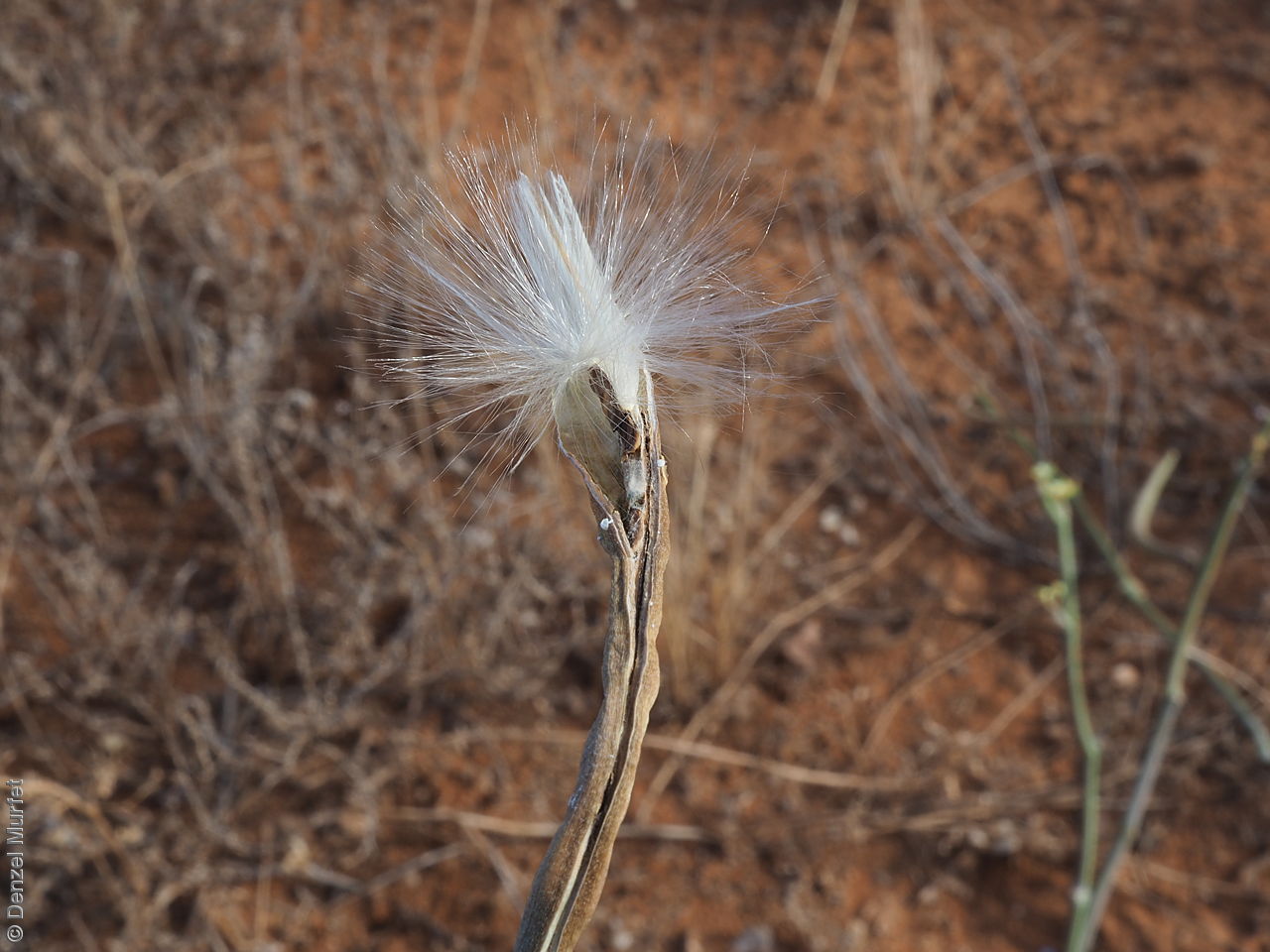Caustic Vine,
Caustic Bush
Display all 13 images













Regional Species Conservation Assessments per IBRA subregion.


Least concern
Near threatened
Rare
Vulnerable
Endangered
Critically endangered
Extinct
Data deficient
Adelaide
Arkaroola
Ceduna
Coober Pedy
Hawker
Innamincka
Marla
Marree
Mount Gambier
Oodnadatta
Renmark
Wudinna
Keith
Yunta
Display IBRA region text
| Fleurieu (KAN02) | Kanmantoo | Vulnerable (IUCN: VU D2) [cliff edges, only 2 known pops] |
| Broughton (FLB02) | Flinders Lofty Block | Rare (IUCN: RA d(ii)) (Probable Decline) |
| Olary Spur (FLB03) | | Rare (IUCN: RA d(ii)) (Probable Decline) |
| Southern Flinders (FLB04) | | Rare (IUCN: RA d(ii)) (Probable Decline) |
| Northern Flinders (FLB05) | | Least Concern |
| Central Flinders (FLB06) | | Near Threatened |
| St Vincent (EYB02) | Eyre Yorke Block | Critically Endangered (IUCN: CR D) (Probable Decline) [Records in Tickeria] |
| Eyre Hills (EYB03) | | Rare (IUCN: RA d(ii)) [southern limit] |
| Murray Mallee (MDD02) | Murray Darling Depression | Rare (IUCN: RA d(i,ii)) |
| Braemer (MDD07) | | Rare (IUCN: RA d(ii)) (Probable Decline) |
| Murray Scroll Belt (RIV06) | Riverina | Rare (IUCN: RA d(i,ii)) |
| Myall Plains (GAW01) | Gawler | Rare (IUCN: RA d(ii)) |
| Gawler Volcanics (GAW02) | | Rare (IUCN: RA d(ii)) |
| Gawler Lakes (GAW03) | | Rare (IUCN: RA d(ii)) |
| Arcoona Plateau (GAW04) | | Least Concern |
| Kingoonya (GAW05) | | Rare (IUCN: RA d(ii)) |
| Torrens (GAW06) | | Near Threatened |
| Kintore (GVD04) | Great Victoria Desert | Rare (IUCN: RA d(ii)) |
| Yellabinna (GVD06) | | Rare (IUCN: RA d(i,ii)) |
| Bimbowrie (BHC05) | Broken Hill Complex | Rare (IUCN: RA d(ii)) (Probable Decline) |
| Strzelecki Desert (SSD05) | Simpson Strzelecki Dunefields | Near Threatened |
| Breakaways (STP01) | Stony Plains | Near Threatened |
| Oodnadatta (STP02) | | Near Threatened |
| Murnpeowie (STP03) | | Near Threatened |
| Witjira (STP06) | | Near Threatened |
| Baltana (STP07) | | Least Concern |
| Sturt Stony Desert (CHC02) | Channel Country | Near Threatened |
| Mann-Musgrave Block (CER01) | Central Ranges | Least Concern |
| Watarru (CER02) | | Near Threatened |
| Everard Block (CER03) | | Near Threatened |
| Tieyon (FIN03) | Finke | Rare (IUCN: RA d(ii)) |
| Fleurieu (KAN02) | Kanmantoo | Vulnerable (IUCN: VU D2) [cliff edges, only 2 known pops] |
| 5 of 6 subregions | Flinders Lofty Block | Least Concern , Near Threatened , Rare |
| 2 of 5 subregions | Eyre Yorke Block | Rare , Critically Endangered |
| 2 of 6 subregions | Murray Darling Depression | Rare |
| Murray Scroll Belt (RIV06) | Riverina | Rare (IUCN: RA d(i,ii)) |
| 6 of 8 subregions | Gawler | Least Concern , Near Threatened , Rare |
| 2 of 4 subregions | Great Victoria Desert | Rare |
| Bimbowrie (BHC05) | Broken Hill Complex | Rare (IUCN: RA d(ii)) (Probable Decline) |
| Strzelecki Desert (SSD05) | Simpson Strzelecki Dunefields | Near Threatened |
| 5 of 7 subregions | Stony Plains | Least Concern , Near Threatened |
| Sturt Stony Desert (CHC02) | Channel Country | Near Threatened |
| 3 of 3 subregions | Central Ranges | Least Concern , Near Threatened |
| Tieyon (FIN03) | Finke | Rare (IUCN: RA d(ii)) |
Botanical art
Kath Alcock paintings: 2
Prior names
Sarcostemma viminale ssp. australe
Sarcostemma australe
Common names
Caustic Vine
Caustic Bush
Etymology
Cynanchum from the Greek 'kyon' meaning a dog and 'anchein' meaning to choke; alluding to supposed poisonous properties of some European species. Viminale from the Latin 'vimineus' meaning bearing osiers (a shoot of a willow); alluding to the species having long flexible shoots like the willow. Australis from Latin meaning southern; referring to the species distribution in Australia.
Distribution and status
Found across much of South Australia, growing in woodland and scrub, often on rock outcrops and in coastal sites. Also found in Western Australia, Northern Territory, Queensland and New South Wales. Native. Common in South Australia. Common in the other states.
Herbarium regions: North Western, Lake Eyre, Gairdner-Torrens, Flinders Ranges, Eastern, Eyre Peninsula, Northern Lofty, Murray, Yorke Peninsula, Southern Lofty
NRM regions: Adelaide and Mount Lofty Ranges, Alinytjara Wilurara, Eyre Peninsula, Northern and Yorke, South Australian Murray-Darling Basin
AVH map: SA distribution map (external link)
Plant description
Shrub to 2 m high or with prostrate stems longer. Leaves opposite, scale-like. Inflorescence an umbel with 2-10 pale yellow to whitish flowers. Flowers in spring to summer. Fruits are brown capsule to 14 cm long and 10 mm wide, tapering to a long point, outer surface finely veined, sometimes tuberculate, inner surface smooth, shiny, pale-brown. Seeds are pale-brown, flattened seed to 7 mm long and 4 mm wide, with long silky pappus.
Seed collection and propagation
Collect seeds between December and April. Collect fruits that are maturing, fat, hard, turning pale brown and contain fluffy seeds. Place the fruit in a tray and leave to dry for at least two weeks until it split. Then shake the fruits to release the seeds. No further cleaning is required. Store the seeds with a desiccant such as dried silica beads or dry rice, in an air tight container in a cool and dry place.













